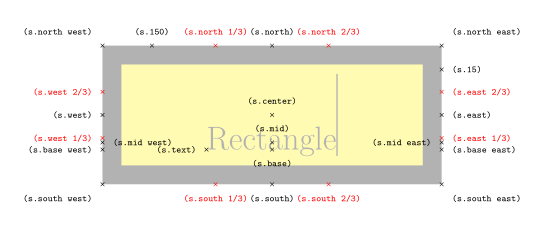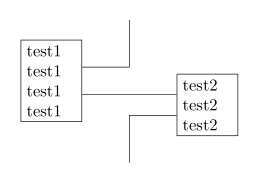|
Auf golatex.de wurde die Frage gestellt, wie man zu einem bereits definierten shape weitere Anker hinzufügen kann. Konkret sollen zu einem Hier ist das bereits definierte
Code (im wesentlichen aus dem pgfmanual): \documentclass[tikz,margin=5mm]{standalone} \tikzset{ shape example/.style= {color = black!30,draw,fill = yellow!30, line width = .5cm,inner xsep = 2.5cm,inner ysep = 0.5cm} } \begin{document} \Huge \begin{tikzpicture} \node[name=s,shape=rectangle,shape example] {Rectangle\vrule width 1pt height 2cm}; % bisherige Anker einzeichnen lassen \foreach \anchor/\placement in {north west/above left, north/above, north east/above right, west/left, center/above, east/right, mid west/right, mid/above, mid east/left, base west/left, base/below, base east/right, south west/below left, south/below, south east/below right, text/left, 15/right,150/above} \draw[shift=(s.\anchor)] plot[mark=x] coordinates{(0,0)} node[\placement,font=\scriptsize] {\texttt{(s.\anchor)}}; \end{tikzpicture} \end{document} Wie kann ich mir jetzt ein shape definieren, das zusätzlich die Anker north 1/3, north 2/3 etc. hat? |
|
Zunächst lohnt ein Blick in die Datei \pgfdeclareshape{myrectangle}{ % es wird zunächst alles vom rectangle übernommen \inheritsavedanchors[from=rectangle] \inheritanchorborder[from=rectangle] \foreach \a in {% center,mid,base,north,south,west,east,% north west,mid west,base west,south west,% north east,mid east,base east,south east% }{\inheritanchor[from=rectangle]{\a}} \inheritbackgroundpath[from=rectangle] } Für das Der Anker Dabei wird zunächst die x-Koordinate des
Code: \documentclass[tikz,margin=5mm,convert=false]{standalone} \makeatletter \pgfdeclareshape{myrectangle}{ % es wird zunächst alles vom rectangle übernommen \inheritsavedanchors[from=rectangle] \inheritanchorborder[from=rectangle] \foreach \a in {% center,mid,base,north,south,west,east,% north west,mid west,base west,south west,% north east,mid east,base east,south east% }{\inheritanchor[from=rectangle]{\a}} \inheritbackgroundpath[from=rectangle] % dann werden die zusätzlichen Anker ergänzt \anchor{north 1/3}{ \southwest\pgf@xa=\pgf@x \northeast\pgfmathsetlength\pgf@x{\pgf@xa-(\pgf@xa-\pgf@x)/3} } \anchor{north 2/3}{ \southwest\pgf@xa=\pgf@x \northeast\pgfmathsetlength\pgf@x{\pgf@x-(\pgf@x-\pgf@xa)/3} } \anchor{south 1/3}{ \northeast\pgf@xa=\pgf@x \southwest\pgfmathsetlength\pgf@x{\pgf@x-(\pgf@x-\pgf@xa)/3} } \anchor{south 2/3}{ \northeast\pgf@xa=\pgf@x \southwest\pgfmathsetlength\pgf@x{\pgf@xa-(\pgf@xa-\pgf@x)/3} } \anchor{east 1/3}{ \southwest\pgf@ya=\pgf@y \northeast\pgfmathsetlength\pgf@y{\pgf@ya-(\pgf@ya-\pgf@y)/3} } \anchor{east 2/3}{ \southwest\pgf@ya=\pgf@y \northeast\pgfmathsetlength\pgf@y{\pgf@y-(\pgf@y-\pgf@ya)/3} } \anchor{west 1/3}{ \northeast\pgf@ya=\pgf@y \southwest\pgfmathsetlength\pgf@y{\pgf@y-(\pgf@y-\pgf@ya)/3} } \anchor{west 2/3}{ \northeast\pgf@ya=\pgf@y \southwest\pgfmathsetlength\pgf@y{\pgf@ya-(\pgf@ya-\pgf@y)/3} } } \makeatother \tikzset{ shape example/.style= {color = black!30,draw,fill = yellow!30, line width = .5cm,inner xsep = 2.5cm,inner ysep = 0.5cm} } \begin{document} \Huge \begin{tikzpicture} \node[name=s,shape=myrectangle,shape example] {Rectangle\vrule width 1pt height 2cm}; % bisherige Anker einzeichnen lassen \foreach \anchor/\placement in {north west/above left, north/above, north east/above right, west/left, center/above, east/right, mid west/right, mid/above, mid east/left, base west/left, base/below, base east/right, south west/below left, south/below, south east/below right, text/left, 15/right,150/above} \draw[shift=(s.\anchor)] plot[mark=x] coordinates{(0,0)} node[\placement,font=\scriptsize] {\texttt{(s.\anchor)}}; % neue Anker einzeichnen lassen \foreach \anchor/\placement in {{north 1/3}/above,{north 2/3}/above,{south 1/3}/below,{south 2/3}/below, {east 1/3}/right,{east 2/3}/right,{west 1/3}/left,{west 2/3}/left} \draw[shift=(s.\anchor),red] plot[mark=x] coordinates{(0,0)} node[\placement,font=\scriptsize\bfseries] {\texttt{(s.\anchor)}}; \end{tikzpicture} \end{document} Damit kann man dann zum Beispiel folgendes machen (Beispiel aus der Frage auf golatex.de): \begin{tikzpicture}[text width=3em] \node[draw,myrectangle] (test1) {test1\\test1\\test1\\test1}; \draw (test1.east 2/3) -|++(1,1){}; \draw(test1.east 1/3)-- +(2,0)node[draw,myrectangle,anchor=west 2/3](test2){test2\\test2\\test2}; \draw(test2.west 1/3)-|+(-1,-1); \end{tikzpicture} und erhält
Sehr schön! Ich fand noch Martins Ansatz, der wohl mit TikZ 3 laut einem Kommentar nicht mehr so gehen sollte.
(26 Jun '14, 00:54)
stefan ♦♦
|



